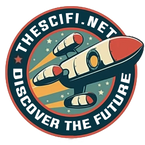In this blog we will dive into one of most read sci-fi series Isaac Asimov's Foundation series and Robot series and its reading order.
The writer Isaac Asimov penned the Foundation cycle. "The Foundation Trilogy" is one of the most important works of the science fiction genre. Asimov combined this trilogy with his numerous robot and empire novels to form an extensive cycle about the construction of a new civilization in space. The Foundation books by Isaac Asimov have been reissued since 2014. This list corresponds to the best of Asimov’s to read in an internal chronology. Even Asimov offered a chronological order in the ‘Author’s Note’ at the beginning of Prelude to Foundation, this is our special list follows the magic. Besides, you can see the full list below according to Asimov’s note.

1- Robot
Robots on the rise.
Dr. Susan Calvin was employed as a robot psychologist for the US Robot Company, one of the largest corporations in the world, for fifty years. She experienced firsthand how robots became an everyday part of human culture and the problems that arise when people live with robots. Above all, however, one question arises: what happens when humans and robots hardly differ from one another? In nine stories she shows a young reporter what a future shaped by gigantic positron brains looks like for us humans.
2- The Complete Robot
A look into the future.
Claire Belmont, wife of an employee of the US Robot Company, is to test the model TN3, known as Tony, as a domestic helper. She only reluctantly agrees to the project, she is not entirely at ease with robots. However, Tony is programmed to fulfill her every wish - and he recognizes more than just the obvious ... In ten short stories, Isaac Asimov looks into the future in "The Complete Robot", the cornerstones of which are already being laid today. Together with “The Robot” and “The Bicentennial Man”, Asimov also lays the foundation for his gigantic Future History, the Foundation cycle.

3- The Bicentennial Man
Human rights for robots?
Andrew, the Martin family's household robot, develops into a successful artist with the support of the head of the family, Gerald. All Martins, but especially their little daughter Mandy, find Andrew more and more likeable - and more and more human. But when Andrew decides to legally enforce his human condition in court, there is a falling out with Gerald, but Mandy has supported Andrew all her life ... In addition to the eponymous short story "The Bicentennial", Isaac Asimov brings together eight other stories in the third volume of robots from his robot / foundation universe.
4- The Caves of Steel
Can robots and humans work together?
At the beginning of the 30th century, humankind is divided: some live on earth, crammed together under huge domes, others - the so-called "spacers" - have settled on foreign planets. But with the spatial separation, both parties develop very different worldviews, especially when it comes to the robots that are frowned upon on earth. Elijah Baley of the New York City Police is anything but enthusiastic about his new case: a Spacer diplomat is found murdered. Baley is supposed to investigate together with a robot and thus prevent any political expansion of this unpleasant case. The fact that R. Daneel is a highly developed Android, which can no longer be distinguished from a human, does not make working together for Baley any easier ...

5- The Stars, Like Dust, The Currents in Space, Peeble in the Sky
With his vision of the future that spanned thousands of years, Isaac Asimov left a lasting mark on science fiction literature and prepared the ground for authors such as Greg Bear, David Brin and Gregory Benford.. Isaac Asimov tells the prehistory of his famous Foundation trilogy: It all begins with an ordinary day in 1949 when the retired tailor Joseph Schwartz down a street Strolling down Chicago - and suddenly find yourself in a completely different place at a completely different
6- Foundation and Empire
The center of the galaxy is ruled by Emperor Cleon I. Hari Seldon, a young scientist, presents his theory of psychohistory for the first time, which uses mathematical, sociological and statistical methods to make precise predictions about behavior makes possible for large groups of people - empires, for example. Cleon I. becomes aware of this and wants Seldon's help. Cleons' first minister, Eto Demerzel, in particular, does not seem to be enthusiastic about this project. Hari Seldon has to flee from Trantor and goes in search of the ancient earth, and his opponents are constantly on his heels...

7- Foundation
The year is 12020. Cleon I rules his gigantic star kingdom from the capital Trantor. But the empire is showing its first cracks, and the emperor knows that his rule is threatened. An uncertain future lies ahead of him, dark and ominous, because all prognoses claim that the decay cannot be stopped. Not even the latest science, psychohistory, can do anything against impending doom...
ASIMOV’S OWN LIST
- I, Robot
- The Caves of Steel
- The Naked Sun
- The Robots of Dawn
- Robots and Empire
- The Stars, Like Dust
- The Currents of Space
- Pebble in the Sky
- Prelude to Foundation
- Foundation
- Foundation and Empire
- Second Foundation
- Foundation’s Edge
- Foundation and Earth
Written by gamzeno
You read Jules Vernes' life and his adventure. If you want to read blogs about sci fi visit our website TheSciFi.Net.
